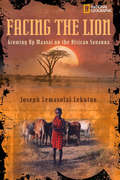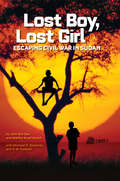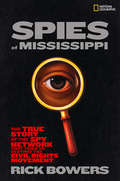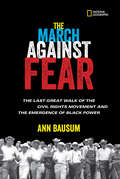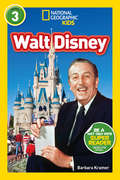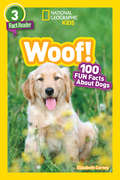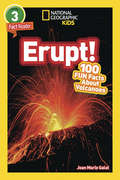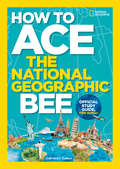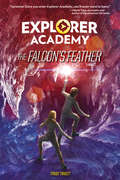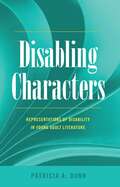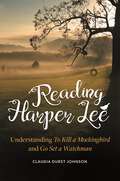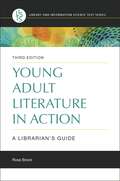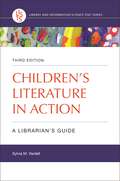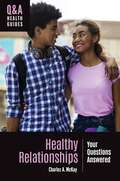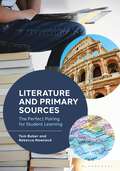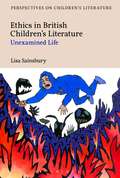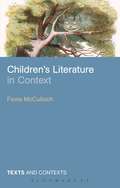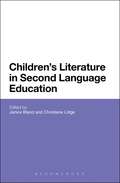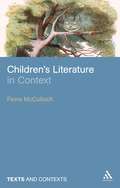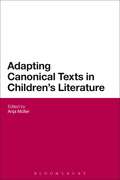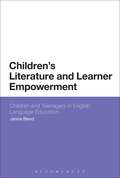- Table View
- List View
Facing the Lion: Growing Up Maasai On The African Savanna (Biography)
by Joseph Lemasolai Lekuton Herman J. Viola National Geographic KidsJoseph Lemasolai Lekuton gives American kids a firsthand look at growing up in Kenya as a member of a tribe of nomads whose livelihood centers on the raising and grazing of cattle. Readers share Lekuton's first encounter with a lion, the epitome of bravery in the warrior tradition. They follow his mischievous antics as a young Maasai cattle herder, coming-of-age initiation, boarding school escapades, soccer success, and journey to America for college. Lekuton's riveting text combines exotic details of nomadic life with the universal experience and emotions of a growing boy.
Lost Boy, Lost Girl: Escaping Civil War In Sudan (Biography)
by John Bul Dau National Geographic KidsOne of thousands of children who fled strife in southern Sudan, John Bul Dau survived hunger, exhaustion, and violence. His wife, Martha, endured similar hardships. In this memorable book, the two convey the best of African values while relating searing accounts of famine and war. There’s warmth as well, in their humorous tales of adapting to American life. For its importance as a primary source, for its inclusion of the rarely told female perspective of Sudan’s lost children, for its celebration of human resilience, this is the perfect story to inform and inspire young readers.
Spies of Mississippi: : The True Story Of The Spy Network That Tried To Destroy The Civil Rights Movement (16pt Large Print Edition) (History (US))
by Rick Bowers National Geographic KidsThe Spies of Mississippi is a compelling story of how state spies tried to block voting rights for African Americans during the Civil Rights era. This book sheds new light on one of the most momentous periods in American history.
The March Against Fear: The Last Great Walk Of The Civil Rights Movement And The Emergence Of Black Power (History (US))
by Ann Bausum National Geographic KidsJames Meredith's 1966 march in Mississippi began as one man's peaceful protest for voter registration and became one of the South's most important demonstrations of the civil rights movement.
National Geographic Kids Readers: Walt Disney (National Geographic Kids Readers: Level 3)
by Barbara Kramer National Geographic KidsFans of Disneyland, Disney World, and all things Disney are sure to enjoy learning all about the fascinating founder, Walt Disney.
National Geographic Kids Readers: Woof! 100 Fun Facts About Dogs (l3) (National Geographic Kids Readers: Level 3)
by Elizabeth Carney National Geographic KidsKids will dig learning all about dogs in this new National Geographic Kids Reader.
National Geographic Kids Readers: Erupt!: 100 Fun Facts About Volcanoes (National Geographic Kids Readers: Level 3)
by Joan Marie Galat National Geographic KidsKids will burst with excitement as they learn all about the science and wonder of volcanoes in this new National Geographic Kids Reader.
How to Ace the National Geographic Bee: Official Study Guide (National Geographic Bee)
by National Geographic KidsThe National Geographic Bee is a local, state, and national academic contest for students in grades four through eight. The competition culminates in a finals face-off, broadcast live on National Geographic Television. This is the ultimate guide for gearing up for the events.
The Falcon’s Feather: The Falcon's Feather (Explorer Academy)
by National Geographic KidsDanger, mystery, and high adventure await as Cruz boards the Explorer Academy ship on a dangerous mission to the icy north in search of the first piece of his mother's hidden cypher.
Disabling Characters: Representations Of Disability In Young Adult Literature
by Patricia A. DunnDisabling Characters provides detailed analyses of selected young adult (YA) novels and short stories. It looks at the relative agency of the disabled character, the behavior of the other characters, the environment in which the character must live, the assumptions that seem to be underlying certain scenes, and the extent to which the book challenges or perpetuates an unsatisfactory status quo. Class discussions about disability-themed literature, however well intentioned, have the potential to reinforce harmful myths or stereotypes about disability. In contrast, discussions informed by a critical disability studies perspective can help readers develop more sophisticated views of disability and contribute to a more just and inclusive society. The book examines discussion questions, lesson plans, study guides, and other supplemental materials aimed at students studying these texts, and it suggests more critical questions to pose about these texts and the positive and/or negative work they do, perhaps subliminally, in our culture. This book is a much-needed addition to college classes in YA literature, literary analysis, methods of teaching literature, disability studies, cultural studies, contemporary criticism, special education, and adolescent literacy.
Mental Illness in Young Adult Literature: Exploring Real Struggles through Fictional Characters
by Kia Jane RichmondThis book explores how mental illness is portrayed in 21st-century young adult fiction and how selected works can help teachers, librarians, and mental health professionals to more effectively address the needs of students combating mental illness.Mental Illness in Young Adult Literature: Exploring Real Struggles through Fictional Characters highlights American young adult literature published since the year 2000 that features characters grappling with mental illness. Chapters focus on mental disorders identified by the most recent Diagnostic and Statistical Manual of Mental Disorders (DSM-5), including anxiety, depression, bipolar disorder, schizophrenia, ADHD, and OCD. Each chapter begins with a description of a mental illness that includes its prevalence, demographic trends, symptoms, related disorders, and treatment options before examining a selection of young adult texts in depth. Analysis of the texts explores how a mental illness manifests for a particular character, how that character perceives him- or herself and is perceived by others, and what treatment or support he or she receives. The connections between mental illness and race, ethnicity, gender, sexuality, and identity are examined, and relevant research from education, psychology, and adolescent health is thoroughly integrated. Each chapter also provides a list of additional readings. An appendix offers strategies for integrating young adult literature into health curricula and other programs.
Reading Harper Lee: Understanding To Kill a Mockingbird and Go Set a Watchman
by Claudia Durst JohnsonThe first book-length study of Harper Lee's two novels, this is the ultimate reference for those interested in Harper Lee's writing, most notably as it considers race, class, and gender.To Kill a Mockingbird is timeless, continuing to be a favorite among both students and adults. One million copies are sold every year, and it remains one of the books most often taught in school. This companion guide helps students to better understand the complex themes of race, class, and gender that were first introduced in To Kill a Mockingbird and remain relevant in Go Set a Watchman, which both challenges and mirrors the topics discussed in Lee's first novel. A literary scholar and a friend of Harper Lee herself, author Claudia Durst Johnson brings a unique perspective to Lee's texts. The book provides a historical background of the Great Depression and the beginning of the Civil Rights Movement as well as an analysis of the widespread censorship of Lee's works. Chapters provide important context for topics such as racial issues, women's issues, and class divisions in the Deep South and serve as discussion points that give students a starting point for their research; similarly, teachers who struggle with how to introduce students to these challenging but timely topics will appreciate the wealth of knowledge this companion guide will deliver.
Young Adult Literature in Action: A Librarian's Guide (Library and Information Science Text Series)
by Rose BrockTaking a genre approach, this overview of young adult literature shows new librarians and library science students the criteria to use for selecting quality books, including recommended titles.This third edition of Young Adult Literature in Action draws on the success of the previous two editions authored by Rosemary Chance, updating and expanding on them to meet the needs of today's librarians and library science students. It includes a new focus on diverse books, LGBTQ+ selections, the role of book formats, and the relevance of librarians serving teen populations and is an ideal resource for teaching young adult literature courses.Organized by major genre divisions, this easy-to-use book includes new information on timely topics such as audio and e-books, accessible books, and graphic novels. Each chapter includes revised and updated information on collaborative activities, featured books, special topics and programs, selected awards and celebrations, historical connections, recommended resources, issues for discussion, author comments, and assignment suggestions. Further updates include citations of exemplary young adult books and award winners, references, websites, and a bibliography.
Children's Literature in Action: A Librarian's Guide (Library and Information Science Text Series)
by Sylvia M. VardellThis practitioner-oriented introduction to literature for children ages 5–12 covers the latest trends, titles, and tools for choosing the best books and materials as well as for planning fun and effective programs and activities.The third edition of Children's Literature in Action provides an activity-oriented survey of children's literature for undergraduate and graduate students seeking licensure and degrees that will lead to careers working with children in schools and public libraries. Author Sylvia M. Vardell draws on her 30 years of university teaching and extensive familiarity with the major textbooks in the area of children's literature to deliver something different: a book that focuses specifically on the perspective and needs of the librarian, with emphasis on practical action and library applications. Its contents address seven major genres: picture books, traditional tales, poetry, contemporary realistic fiction, historical fiction, fantasy, and informational books. Each chapter includes practical applications for the educator who shares books with children and who develops literature-based instruction. Chapters are enriched by author comments, collaborative activities, featured books, special topics, and activities including selected awards and celebrations, historical connections, recommended resources, issues for discussion, and assignment suggestions. This new edition incorporates the 2018 AASL National School Library Standards.
Healthy Relationships: Your Questions Answered (Q&A Health Guides)
by Charles A. McKayIntended for young readers interested in creating and maintaining physically and emotionally healthy relationships, this book answers common questions and offers practical guidance on navigating such everyday issues as conflict resolution and jealousy.Part of Bloomsbury's Q&A Health Guides series and authored by a clinical psychotherapist, this book equips readers with the knowledge and tools they need to pursue safe and meaningful romantic relationships. Although many teens and young adults are interested in dating, entering into the worldof romantic relationships can spark a number of difficult questions. This book's 46 questions address concerns related to attractiveness, readiness for a relationship, building connection and trust, conflict, sexual health, setting boundaries, and breakups:- How do you know when you're ready to date?- Is conflict normal, and how do you deal with it?- What are the warning signs that a relationship is toxic or abusive?- How do you handle a breakup and the sometimes messy aftermath?.The text strikes a balance between theory and practice, offering clear explanations of foundational concepts in psychology and interpersonal communication, as well as useful suggestions that readers can implement in their own lives.Augmenting the main text, a collection of 5 case studies illustrate key concepts and issues through relatable stories and insightful recommendations. The "Common Misconceptions" section dispels 5 long-standing myths about relationships, directing readers to additional information in the text. The glossary defines terms that may be unfamiliar to readers, while a directory of resources curates a list of the most useful relationship-related books, websites, and other materials. Finally, readers can turn to the "Guide to Health Literacy" section for skills and strategies for finding, evaluating, and using credible sources of health information both on and off the Internet.
Literature and Primary Sources: The Perfect Pairing for Student Learning
by Tom Bober Rebecca NewlandEnrich student engagement and deepen learning with this guide to foolproof techniques and strategies to integrate primary sources and literature to benefit learners from kindergarten through high school.Readers of all ages experience literature in a different light when historical context is provided via primary sources. Literature, meanwhile, helps learners to uncover additional layers of meaning inherent in primary sources. Guided by best practices developed by the authors over years of working with both students and teachers, this book speaks to the countless opportunities for instructors to integrate related primary sources with the literature that students read in school classrooms-from historical fiction and poetry to graphic novels.
Ethics in British Children's Literature: Unexamined Life (Bloomsbury Perspectives on Children's Literature)
by Lisa SainsburyFeaturing close readings of selected poetry, visual texts, short stories and novels published for children since 1945 from Naughty Amelia Jane to Watership Down, this is the first extensive study of the nature and form of ethical discourse in British children's literature.Ethics in British Children's Literature explores the extent to which contemporary writing for children might be considered philosophical, tackling ethical spheres relevant to and arising from books for young people, such as naughtiness, good and evil, family life, and environmental ethics. Rigorously engaging with influential moral philosophers, from Aristotle through Kant and Hegel, to Arno Leopold, Iris Murdoch, Mary Midgley, and Lars Svendsen, this book demonstrates the narrative strategies employed to engage young readers as moral agents.
Children's Literature in Context (Texts and Contexts)
by Fiona McCullochChildren's Literature in Context is a clear, accessible and concise introduction to children's literature and its wider contexts. It begins by introducing key issues involved in the study of children's literature and its social, cultural and literary contexts. Close readings of commonly studied texts including Lewis Carroll's Alice books, The Wonderful Wizard of Oz, The Lion, the Witch and the Wardrobe, the Harry Potter series and the His Dark Materials trilogy highlight major themes and ways of reading children's literature. A chapter on afterlives and adaptations explores a range of wider cultural texts including the film adaptations of Harry Potter, The Chronicles of Narnia and The Golden Compass. The final section introduces key critical interpretations from different perspectives on issues including innocence, gender, fantasy, psychoanalysis and ideology. 'Review, Reading and Research' sections give suggestions for further reading, discussion and research. Introducing texts, contexts and criticism, this is a lively and up-to-date resource for anyone studying children's literature.
Children's Literature in Second Language Education
by Janice Bland Christiane LütgeBringing together leading scholars and teacher educators from across the world, from Europe and the USA to Asia, this book presents the latest research and new perspectives into the uses of children's literature in second language teaching for children and young adults. Children's Literature in Second Language Education covers such topics as extensive reading, creative writing in the language classroom, the use of picturebooks and graphic novels in second language teaching and the potential of children's literature in promoting intercultural education. The focus throughout the book is on creative approaches to language teaching, from early years through to young adult learners, making this book an essential read for those studying or embarking on second language teaching at all levels.
Children's Literature in Context (Texts and Contexts)
by Fiona McCullochChildren's Literature in Context is a clear, accessible and concise introduction to children's literature and its wider contexts. It begins by introducing key issues involved in the study of children's literature and its social, cultural and literary contexts. Close readings of commonly studied texts including Lewis Carroll's Alice books, The Wonderful Wizard of Oz, The Lion, the Witch and the Wardrobe, the Harry Potter series and the His Dark Materials trilogy highlight major themes and ways of reading children's literature. A chapter on afterlives and adaptations explores a range of wider cultural texts including the film adaptations of Harry Potter, The Chronicles of Narnia and The Golden Compass. The final section introduces key critical interpretations from different perspectives on issues including innocence, gender, fantasy, psychoanalysis and ideology. 'Review, Reading and Research' sections give suggestions for further reading, discussion and research. Introducing texts, contexts and criticism, this is a lively and up-to-date resource for anyone studying children's literature.
Jane Austen and Children
by David SelwynJane Austen is not usually associated with children - especially since she had none of her own. But there are in fact more children in her novels than one might at first think. She herself was from a sizeable family, with numerous nephews and nieces. She was, by all accounts, good with children and popular with them. It was therefore natural for her to include them in her novels, even if sometimes offstage. This book, by one of the world's leading authorities on Austen, looks at both the real and the literary children in her life - children seen and unseen (and dead); children as models of behaviour, good and bad; as objects of affection, amusement, usefulness, pity, regret, jealousy, resentment; children in the way; children as excuses; children as heirs. In the process it casts fascinating light on a hitherto largely ignored aspect of her work and the age in which she lived.
Adapting Canonical Texts in Children's Literature
by Anja MüllerAdaptations of canonical texts have played an important role throughout the history of children's literature and have been seen as an active and vital contributing force in establishing a common ground for intercultural communication across generations and borders. This collection analyses different examples of adapting canonical texts in or for children's literature encompassing adaptations of English classics for children and young adult readers and intercultural adaptations of children's classics across Europe. The international contributors assess both historical and transcultural adaptation in relation to historically and regionally contingent concepts of childhood. By assessing how texts move across age-specific or national borders, they examine the traces of a common literary and cultural heritage in European children's literature.
Children's Literature and Learner Empowerment: Children and Teenagers in English Language Education
by Janice BlandChildren's literature can be a powerful way to encourage and empower EFL students but is less commonly used in the classroom than adult literature. This text provides a comprehensive introduction to children's and young adult literature in EFL teaching. It demonstrates the complexity of children's literature and how it can encourage an active community of second language readers: with multilayered picturebooks, fairy tales, graphic novels and radical young adult fiction. It examines the opportunities of children's literature in EFL teacher education, including: the intertexuality of children's literature as a gate-opener for canonised adult literature; the rich patterning of children's literature supporting Creative Writing; the potential of interactive drama projects. Close readings of texts at the centre of contemporary literary scholarship, yet largely unknown in the EFL world, provide an invaluable guide for teacher educators and student teachers, including works by David Almond, Anthony Browne, Philip Pullman and J.K.Rowling. Introducing a range of genres and their significance for EFL teaching, this study makes an important new approach accessible for EFL teachers, student teachers and teacher educators.
Adapting Canonical Texts in Children's Literature
by Anja MüllerAdaptations of canonical texts have played an important role throughout the history of children's literature and have been seen as an active and vital contributing force in establishing a common ground for intercultural communication across generations and borders. This collection analyses different examples of adapting canonical texts in or for children's literature encompassing adaptations of English classics for children and young adult readers and intercultural adaptations of children's classics across Europe. The international contributors assess both historical and transcultural adaptation in relation to historically and regionally contingent concepts of childhood. By assessing how texts move across age-specific or national borders, they examine the traces of a common literary and cultural heritage in European children's literature.
